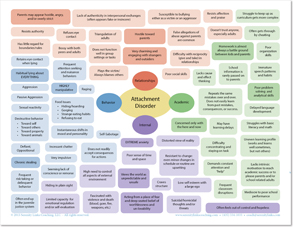What is RAD?
“RAD is the condition in which individuals have difficulty forming loving, lasting relationships. They often have a nearly complete lack of ability to be genuinely affectionate to others. They typically fail to develop a conscience and do not learn to trust. They do not allow people to be in control of them due to this trust issue. They can be surface compliant for weeks if there is no loving relationship involved. With strangers, they can be extremely charming and appear loving. Some adults misinterpret this as the child trusting or caring for them. If they cannot trust and love their own family members who love them, they will not trust and love casual acquaintances!”
(Nancy Thomas, 1997)
“When children are unattached they lack an internalized object. Because of this, they do not mature but instead continue to be self-centered, impulsive, and “babyish.” Their concern is always, “What’s in it for me?“
– – – – – – – – – – – – – –
“Breaks in attachment lead to feelings of anger and rage, grief and hopelessness, poor impulse control and a failure to learn the basic social and cognitive skills necessary for a healthy life.“
(High Risk, 1987)
RAD is not more commonly found in one gender or the other, and can affect birth, adopted, foster, permanent guardianship, and kin-placement children.
For a diagnosis of RAD a child must have experienced at least one of the risk factors, and have half or more of the symptoms.
Risk Factors
Any of the following conditions experienced by a child under 36 months of age puts the child at high-risk for developing RAD:
- Unwanted pregnancy
- In-utero exposure to trauma, drugs, and/or alcohol
- Abuse (physical, emotional, sexual)
- Neglect (not answering the baby’s cries for help)
- Sudden separation from primary caregiver (ie. Illness or death of mother, severe illness or hospitalization of the baby, adoption)
- On-going pain such as colic, many ear infections, hernias, etc…
- Changing daycares or using providers who don’t do bonding
- Moms with chronic depression
- Several moves and/or placements (foster care, failed adoptions)
- Unprepared mothers with poor parenting skills
- Caring for baby on a timed schedule or other parent-centered parenting
High-Risk Symptoms in Infants (birth to around age 4)
- Weak crying response or constant crying
- Tactile defensiveness (flinching or startling after 8 weeks of age)
- Poor clinging or holding on
- Resistance to cuddling, seem “stiff as a board”
- Poor sucking response
- Poor eye contact, lack of tracking (following)
- Developmental delays
- No reciprocal smile response (they don’t return smiles)
- Indifference to others (no “stranger anxiety” after 6 months of age)
- Self-abuse (head banging, etc…)
Attachment Disorder Symptoms in Children (usually age 4 and up)
- Superficially engaging or charming
- Lack of eye contact on parents’ terms
- Indiscriminately affectionate with strangers
- Not affectionate on parents’ terms (not cuddly)
- Destructive to self, others, and material things (accident prone)
- Cruelty to animals
- Lying about the obvious (crazy lying)
- Stealing
- No impulse controls (frequently acts hyperactive)
- Learning lags
- Lack of cause and effect thinking
- Lack of conscience
- Abnormal eating patterns
- Poor peer relationships
- Preoccupation with fire
- Preoccupation with blood and gore
- Persistent nonsense and chatter
- Inappropriately demanding and clinging
- Abnormal speech patterns
- Triangulation of adults
- False allegations of abuse
- Presumptive entitlement issues
- Parents appear hostile and angry
Click HERE to download this amazing FREE RAD-at-a-glance chart from Serenity Links Coaching!
Download this pamphlet on RAD Information to share with friends and family.

